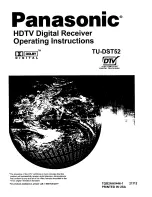
4 - 2
The signals from the pre-amplifier circuit, or signals which
bypass the pre-amplifier, pass through a low-pass filter
(L902, L903, C902–C907). This low-pass filter suppresses
signals above 30 MHz to eliminate direct receiving of signals
at 64.455 MHz and image interference at 130–160 MHz.
The signals are then applied to the 1st mixer
(Q1102–Q1104).
The 1st LO signal (64.485–94.455 MHz) enters the MAIN
unit from the PLL unit via J201 (PLL unit; J4). The LO signal
is amplified at Q201 and then applied to the 1st mixer.
The 1st mxer (Q1101–Q1104) uses four 2SK1740s to pro-
duce high level mixing with a high intercept point.
4-1-5 1ST IF CIRCUIT (MAIN UNIT)
The 1st IF circuit filters and amplifies the 1st IF signals. The
1st IF signals from the 1st mixer circuit are applied to MCF
(Monolithic Crystal Filter: Fl301) to suppress out-of-band
signals. The passband width of FI301 is ±7.5 kHz/–6 dB.
The filtered signals are applied to the 1st IF amplifier
(Q1201). AGC voltage is supplied to the 2nd gate of Q1201.
4-1-6 2ND MIXER CIRCUIT (MAIN UNIT)
The 2nd mixer circuit mixes the amplified 1st IF signals and
2nd LO signal (64.00 MHz) to convert the 1st IF signals into
a 2nd IF signal.
The amplified 1st IF signals from Q1201 are converted into
455 kHz 2nd IF signal at the 2nd mixer (D401). D401 is a
DBM (Double Balanced Mixer). The 2nd LO level is approx.
0 dBm.
The 2nd IF signals are applied to FI1301 to suppress unde-
sired signals such as the 2nd LO signal, and are then
applied to the NB circuit.
4-1-7 NOISE BLANKER CIRCUIT (MAIN UNIT)
The noise blanker circuit detects pulse type noise, and turns
OFF the signal line when noise appears.
The 2nd IF signals from FI1301 are applied to the noise
blanker gate (D1301, D1302). A portion of the signals from
FI1301 is amplified at the noise amplifiers (Q1501, Q1502,
Q1503), then detected at the noise detector (D1501). The
detected signal from the noise detector is applied to the
noise blanker control (Q1508, Q1509).
A portion of the detected signals from the noise detector is
applied to the noise AGC circuit (Q1504, Q1505, R1514,
R1519, C1512) to control the bias voltage of the noise
amplifier (Q1501, Q1502).
The threshold level of the noise blanker switch (Q1508) is
set at 0.9 V. When the detected voltage exceeds the thresh-
old level, Q1509 outputs a blanking signal to close the noise
blanker gate (D1301, D1302), depending on the pulse noise
period. When the operating frequency is changed, the “DN_”
signal line becomes “LOW”, turning Q1509 ON through
D1503. In this case, the noise blanker gate prevents PLL
click noise.
4-1-8 2ND IF CIRCUIT (MAIN UNIT)
The signals passed through the noise blanker gate (D1301,
D1302) are amplified at Q1301. AGC voltage is supplied to
the 2nd gate of Q1301.
When SSB, CW or RTTY mode is selected, the amplified
signals pass through FI611 (FL-65). When an optional CW
narrow filter is installed and CW-N mode is selected, the sig-
nals pass through the CW narrow filter. When AM mode is
selected, the signals bypass the 2nd IF filter.
The filters are selected with mode selecting signals
(SSB/CW, AM, CW-N) and the “T8V” voltage line.
The filtered signal is amplified at Q1603–Q1601 to obtain a
detectable level. AGC voltage is supplied to the 2nd gate of
Q1603. Two thermistors (R1612, R1617), connected to the
gate of Q1602, improves the temperature characteristics of
the receiver gain. R1614 adjusts the receiver gain.
While in SSB, CW or RTTY mode, outputs signal from
Q1601 is applied to the product detector (IC2001). In AM
mode, output signals from Q1601 are shared between the
AM detector (D1901) and AGC detector (D1803).
4-1-9 BFO CIRCUIT (PLL UNIT)
BFO (Beat Frequency Oscillator) frequency is used at the
SSB/CW detector and the balanced modulator. The IC-718
uses a DDS IC for the BFO circuit.
Output signals from the DDS IC (IC2) are filtered by the low-
pass filter (L14, L15, C50–C54), and applied to the product
detector (MAIN unit; IC2001) for receive demodulation.
• Exact 2nd IF frequency
Frequency (kHz)
453.5
456.5
454.1
455.0
Mode
LSB
USB
CW
AM, CW-N
• BFO frequency in each mode
Mode
LSB
USB
CW
CW-N
AM
Receive
453.5
456.5
454.1
455.0
No output
Transmit
453.5
456.5
455.0
455.0
455.0
Frequency (kHz)
• Exact 1st IF frequency
Frequency (MHz)
64.4535
64.4565
64.4541
64.4550
Mode
LSB
USB
CW
AM, CW-N
Summary of Contents for IC-718
Page 1: ...HF TRANCEIVER iC 718 iC 718 ...
Page 54: ...Count on us iC 718 ...









































